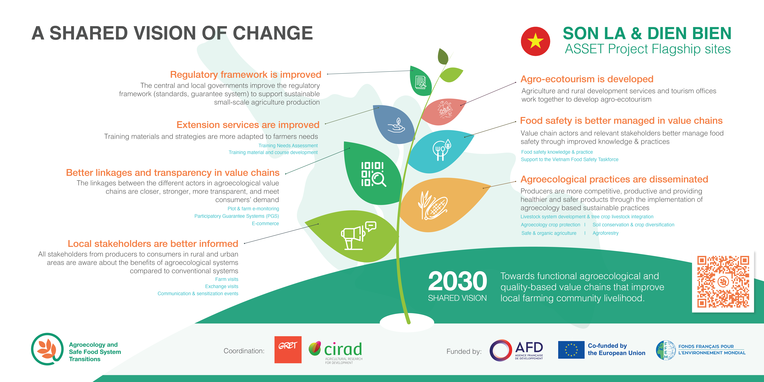Son La & Dien Bien Provinces in Vietnam
Main characteristics
North western region, mountainous areas
- Mountainous subtropical climate (tropical and temperate crops)
- Strong dependency to agriculture (80% of pop.)
- Sloping agriculture (> 75% of cultivation on slopes, soil erosion issues)
- Remote (4 to 10 hours drive from Hanoi)
- Relatively low pop density (Son La Province more populated)
- Rural population (85%)
- High poverty rates (1st and 2nd at national level)
| Sơn La Province | Ðiện Biên Province |
|---|---|
|
14 000 km2 45% forest (~ 630,000 ha) 26% cultivated (~ 360,000 ha) |
9 500 km2 42% forest (~ 400,000 ha) et 38% cultivated (~ 360,000 ha) |
|
1,26 million hab. Thai (55%), Kinh (18%), H’mong (12%) 33% of poors |
0,6 million d’hab. Thai (39%) and H’mong (35%) 40 % of poors |
|
Main economic exchanges: Laos (+ TBU), Hanoi (milk, safe vegetable, pork and poultry) |
Main economic exchanges: Laos, China (Buffalo) Vietnam (rice) |
Main innovations and dynamics
- Support to fruit and industrial crops development in sloping areas
- Support to large ruminant increased /permanent raising in stall
- Support to dry season vegetable production
- Support to Agro – ecotourism development
- Promotion of sloping agricultural land (SALT) / soil conservation technologies
| Development strategy | Sơn La Province | Ðiện Biên Province |
|---|---|---|
| 1. Support to fruit and industrial crop sectors development
- Subsidized seeds/seedlings & fertilizers |
- Fruit: > 2015; about 60,000 ha; +40,000 ha in 5 years - Coffee, Tea |
- Fruit: > 2018; about 5,000 ha; +4,000 ha in 3 years - Coffee, Macadamia |
| 2. Support to Value-chains development
- Farmers organization (cooperatives) |
- Fruits, vegetable, coffee, tea, livestock (pork, cattle) - Many coop., some autonomous and fully operational - VietGap, GlobalGap, Organic - Many Cies for fruit and industrial crop processing |
- Rice, NTPs (honey, medicinal plants), dried meat - Many coop., more recent process, some motiv. leaders - OCOP, Provincial recognition, - Limited number of processing companies; small-size |
| 3. Support to livestock development
- Low interest credits for animals |
- Animal raised in stall model - ~ 7,000 ha of elephant grass and maize for silage production - Local Cie organic fertilizer - FMD, Bovine pasteurellosis |
- Animal raised in stall model - ~ 800 ha of elephant grass and maize for silage production - FMD, Bovine pasteurellosis |
| 4. Support to agro-tourism development
- Local history, landscape beauty |
- Fruit trees blooming, Tea landscape - Tea, milk, honey, vegetable, strawberries, meat |
- DB Museum, Waterfalls - Honey, NTFPs, meat and livestock-related products |
| 5. Some R4D results but no clear objectives/strategies to fight against land degradation in cultivated sloping areas |
- 150,000 ha of maize & cassava - Experience on Agroforestry, forage grass strips, intercrop. |
- 60,000 ha of up. rice & maize - Experience on Agroforestry, forage grass strips, intercrop. |




